|
|
|
|||
|
|
||||
|
|
||||
| Smoke Trails | ||||
|
|
HOME | SITE MAP | FORUM | CONTACT |
|
||
|
ABOUT | MOTORS | MODELS | ARCHIVE | HISTORY | STORE | FAQ | LINKS
|
|
|
|
|
|
||||||||||||||||||||||||||||||||||||||||||||||||||||||||||||||||||||||||||||||||||||||||||||||||||||||||||||||||||||||||||||||||||||||||
|
Smoke Trails 12
(May 2007)
by Roger Simmonds Originally published in SAM 35 Speaks, May 2007 Yet more Ray Models Ray’s Super Rocket, Ray Racer and Jet Wing were, you will remember, discussed in last month’s column. There were apparently other Ray products, about which Ben Nead, who collects these sorts of things, writes: “The illustration [left, upper] is from a full-page advertisement in Air Trails, July 1946. The artist took some liberties making the Jet Streak’s wings built up, as in real life it’s solid balsa throughout. The second illustration [left, lower], from a full-page advert in Air World, January 1946, shows a close up of the Swisher. Unlike the rather fanciful drawings in the other advert, this is a real photo, and thus [hopefully] an accurate rendition of the genuine article. The Ryan Fireball must be a rare one, as I have never seen reference to it anywhere else. Perhaps, like the Jet Streak’s built-up wing, it’s a figment of a copywriter’s or ad designer's imagination!” I don’t know if any of these predated the Ray Racer featured last month. I was obviously wrong thinking the Shooting Star was Ray’s only scale model: the dual power Fireball is amazing, and antedates Richard Crossley’s Rapier/rubber model by nigh on sixty years. Truly, there is nothing new under the sun! Whilst Ray’s claim that their products were the “world’s first jet-propelled models” was disingenuous, they were perhaps the first true kits for reaction-powered models, and the models were, for their time, a considerable achievement. Ben has examples of the Swisher, Jet Wing and the Jet Streak somewhere in his extensive collection, but hasn’t, as yet, managed to track down a Fireball. Perhaps one will turn up on eBay in due course. You never know; stranger things have happened (see later). Both the Swisher and Jet Streak can easily be adapted to Rapier power: the latter in particular is a well-established planform still popular today (think of the Pel-Aero Zephyr), but the Swisher (not to be confused with the later Berkeley Swisher) is not too bad either, and its central fin can conveniently be removed so that there will be no problem with the hot exhaust of any top-mounted Rapier. I hope the plans will be published on Jetex.org soon. If they are indeed all-sheet models, André Bird, for whom these early designs are a speciality (and for André the earlier the better), will be most interested. I would like to see some examples of Air World. It was, according to Ben, “A very nice but short-lived post-WWII publication mostly devoted to full-size aviation with a bit of model airplane info. In this it was almost a mirror image of Air Trails, which was mostly about models. Air World had disappeared from the newsstands by 1948, but was then reinvented as Flying Models. This is still with us (only getting better as the years have gone by) and is one of the last widely circulated US-based model airplane magazines that manage to feature more than just reviews of foamy R/C ARTFs.” Bewitched, or Ever Decreasing Circles Steve Bage has now finished his Keil Kraft DH 110 (or ‘Sea Witch’ as it is called in the KK catalogue) (below right). He modified the wing and tail and deepened the trough (see middle photo, right). Significantly, he also built in anhedral, though this was by mistake. The DH 110 has had a poor reputation today largely because Richard Crossley’s model, built according to Albert Hatfull’s plan, was in Richard’s parlance, “a waster of Rapiers”. So we awaited Steve’s flight report with some trepidation. When his email did arrive, it was nicely entitled ‘Ever decreasing Circles’! Edited extracts of the lively discussion on Jetex.org that followed may help others to tame not only the DH 110 but also other obdurate Jetex ‘Flying Scale’ models like the Super Sabre, Cutlass, and Swift. Or even that latest MiG 19. |
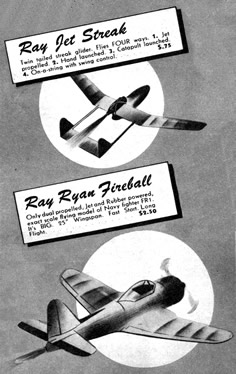 Ray Models’ Jet Streak and Ryan Fireball (“Only dual-propelled, Jet and Rubber powered, exact scale flying model of Navy fighter FR1.”)
- Air Trails, July 1946
 
- Air World, January 1946
|
||||||||||||||||||||||||||||||||||||||||||||||||||||||||||||||||||||||||||||||||||||||||||||||||||||||||||||||||||||||||||||||||||||||||
|
|
|
|||
|
Steve’s flight report began: “Despite a fairly rearward CG, there was no stall under power and the model was stable in pitch. Unfortunately lateral stability was poor. It climbed out beautifully, but any turn that developed (in either direction) gradually tightened into a spiral dive. If trimmed very carefully it was possible to keep the model flying straight enough and long enough to gain sufficient height so that it didn’t ‘spiral in’ under power, but it was prone to spiral even in the glide, so that every return to earth could best be described as a ‘crash’. The only solution is major surgery to put in some dihedral – ½" per side is specified in the plan.” Howard Metcalfe disagreed with this diagnosis, unconvinced that an operation, even under anaesthetic, was necessary. Perhaps a more rearward CG, wing fences, or turned-out rudders were possible cures? He continued his email, “'Spiral divergence' is the correct term for the problem, there being too little lateral stability and too much directional stability from those large twin fins and flat sided tail booms. The two conditions should be treated separately: first stop it diving; then, if you still want to, stop the turning. A catapult over long grass is the safest way to sort things out, gradually increasing the momentum. Adjust bank and trim until you can launch it safely with wings banked at 45° either way. When it goes pretty well right round one circuit and then glides off without hitting the ground you’ve got it about right.” Hmm … Not unexpectedly, this initiated a sometimes quite arcane and technical debate about ‘spiral divergence’ and ‘directional divergence’ with references to NASA sites and some disagreement as to whether there are any overarching laws of aerodynamics, and whether our models would obey them even if there were. Thankfully, all this was good-natured, Howard commenting at one point, “It’s wonderful that our little models don’t know the rules […] I wonder if it isn’t us, and not just our models, that are going round in ‘ever decreasing circles’!” Fortunately, Steve brought us back to reality. Having successfully operated on his model, (putting in, however, rather less dihedral than ½" per side), he made a second trip to the flying field. He reported: “Though still needing careful trim adjustment, it flies in a sedate manner with old 110 mN L-2 motors, and is slightly overpowered with the latest 140 mN motors. Both produce good flights with a nice glide phase. The lateral stability is acceptable but not great, and for an all-weather, easy to trim model, dihedral closer to the recommended ½" would be in order. However, for my taste, the balance between scale fidelity and flying performance is fine. None of this does much to prove what theories are correct, but who cares as long as it flies?” Apparently many modellers do care, and passionately, but I will spare readers the discussion about profile models, side area and the stability enhancing (pendulum) effects of an ‘underslung’ motor. Flyers’ temperaments obviously differ: do you like your models ‘feisty and fun’ or ‘stable and predictable’? We are, I hasten to add, talking model aeroplanes here. I will let Marty Richey, who flies in serious scale competitions where reliability and a good flight performance are de rigueur, have (nearly) the last word. Having checked Richard’s original observations, he observes: “Increasing the dihedral to 3°–4° changed the DH 110’s flight characteristics from ‘crashing’ to acceptable. Steve has rediscovered what all free-flight models need – dihedral! Richard’s model had washout and ½" dihedral. I assume he built the trough and motor mount according to the plan and substituted a Rapier for the Jetex 50. Since Richard’s model had adequate dihedral, but acted like Steve’s [pre-op] model, the keys to Steve’s [eventual] success are effective downthrust, plus adequate dihedral. Steve’s model had a deep modern trough configuration to provide the first requirement, and modification of the wing provided the latter.” |
  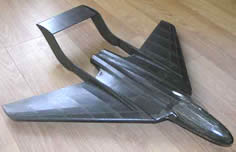
- Steve Bage
|
|||
|
My own opinion about all of this is that our models need to sideslip out of a yaw, and the dihedral Steve added post hoc not only increased lateral stability but also added side area that counteracted the excess fin area. That being said, my Hawker Hunter, which was, by the way, first trimmed exactly as Howard recommends, flies well with a flat wing, as does Mike Stuart’s new Fiat G-91 (right); and Pete Smart’s Douglas Skyrocket is happy with a couple of degrees of anhedral. But, in general, I agree with Marty: the old kit designers were wise – dihedral generally does make for a better flying model, and not everyone, at least without effective medication, can live with the excitement and unpredictability of, say, Howard’s Swift (featured in (Jet)X Files 19, July 2004) or Hubert Kostrzewa’s MiG 17 (Smoke Trails 9). For those now persuaded models need dihedral, the question is now, “how much?”. Steve, who has built and flown more Rapier models over the last couple of years than anyone else I know, has some guidelines, or rules of thumb, that for some reason he neglected to apply to his DH 110. He writes: “Low wings require a minimum of 10° effective dihedral, mid wings require 7° and high wings 4°. For swept wings, each 7 degrees of sweepback (measured at the 25% chord line) is equivalent to 1° of dihedral. I belatedly looked at the case of the 110. As a mid wing design it requires a minimum of 7°. The 40° sweepback provides (40/7) = 5.7°; but, as first built, the 1.5° anhedral resulted in (5.7-1.5) = 4.2° effective dihedral; that is, 2.8° ‘short’ of the minimum. After the surgery it works out like this: 5.7° from the sweepback plus 2° geometric dihedral gives a total of 7.7°, just over the minimum required. Some models can get away with less than that predicted because other factors (fin area etc.) affect the dihedral necessary for stable flight. However, these figures are a reasonable guide.” Thanks Steve, all good stuff. Only one caveat is necessary: deltas need no dihedral ’ that of the old Wilmot Mansour Avro 707 is ridiculous. |
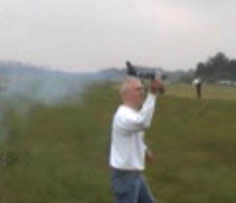 Mike Stuart launches his Fiat G-91, from a video of its second flight at Old Warden aeromodelling weekend, May 2006
- Graham Potter
|
|||
|
Andy Blackwell, having read the preceding paragraphs in draft, wondered if the ‘ever decreasing circles’ weren’t getting tighter and we were in danger of disappearing up our own jet pipes! He returned us to the original conundrum: “It’s frustrating the [Aerographics] Flitzer is a winner, but the DH 110 and Venom, which have similar planforms, are prone to various instabilities. Both are afflicted though, with larger wings and shorter bodies. Graham Potter’s Easy Built Venom [right] has a distinct ‘sine wave’ flight pattern, and my KK Venom of long ago did what Steve’s DH 110 did initially, that is, it banked until it hit the ground. If I’d persisted with it I’m sure that if I’d have been better for it (it’s a practice makes perfect situation), but in those days it was hard to stay enthused as a lone flier. We are fortunate now to have a core of enthusiasts who are interested in sorting these problems out rather than simply binning the model and moving on to something else.” I have been building a KK MiG 15 to replace the one burnt out last year, and, having observed the tendency of the old MiG 15 to ‘Dutch Roll’, I thought less dihedral, or none, would improve matters. In the event, prudence took over, and I only halved the dihedral shown on the plan. It looked ‘just right’ to me. Applying Steve’s guidelines gives the following: 32° sweepback provides about 4.5° dihedral; I built in 3°, giving a grand total of 7.5°. So that’s all right. But then I thought: the Hunter has 36° sweepback; the Skyrocket has a little less and 2° anhedral. Both are mid wing designs … I’ll let you do the sums … Neither has any right to fly as well as they do! I hope we will see, courtesy of Replikit, more Venoms and Vixens, er, I mean ‘Sea Witches’, in the air before long, and I hope folk will be willing to share their experiences of trimming them. Now, I wonder if I can persuade Steve to have a look at another iconic DH twin-boom fighter long overdue for revival: Howard Boys’ Vampire. A new Jet-X fuel Given the continuing uncertainties over the availability of Rapiers, and the very high prices that old Jetex pellets, whether ICI or Sebel, command, it comes as splendid news that Jon Barlow of Powermax has been investing in some R&D. Powermax have recently marketed new pellets and fuse, and our own Special Technical Expert has investigated these at no little expense and risk to himself. Andy (for it is he) reports in a memo worthy of the LSARA: “The pellets are a yellow/green colour, not, as previous Powermax formulations, dark brown. [Andy was quite rude as to what the colour reminded him of. It is, apparently, a hue (or is that a phew?) all too familiar to proud owners of new babies]. They [the pellets, not the babies] are the same size as the old pellets; the grain is also similar, and is still coarser than I'd like. As they aren’t lacquered, the formulation (whatever it is) is open to the atmosphere, so pellets may also absorb water. Also, they are pretty brittle, crushing quite easily. “Initially, I tried them in a 50Z: the first pellet got stuck so I tamped it down with the handle of a small screwdriver. Crunch! However, I loaded two more pellets without incident. Using a Sebel gauze and a two-piece wick configuration, it lit first time and gave a light blue efflux. There was a drop in thrust as the second pellet fired, but when it got to the crushed pellet – whooof! – a significant increase in thrust and a drop in duration. After cooling, I broke the motor down. There was only a half pellet’s worth of green ash, say about a sixth by volume. The gauze was caked with 1/8" of green residue – just like with the old Sebel fuel. I then loaded three pellets into a Sebel 50C and without crushing any. These gave about 20 seconds of effective thrust with only a slight blow past the end cap washer. Again, the gauze was heavily soiled and it had moved down the motor a bit – the gases had bypassed it and residue was probably starting to clog the nozzle towards the end of the run. I then thought, ‘why not try a 50Z again, this time following Powermax’s instructions as if I was a raw beginner?’ But this meant using Powermax’s ‘bowler hat’ gauze. The problem with this is that the residue from hot gases builds up in the small area of the bowl, and this is in the end cap! It took three attempts to light as the fuse wasn’t kept hard against the fuel, and once it did light, the cap blew at about 10 seconds. So beware! It’s absolutely crucial to have proper gauze. The coarser mesh Sebel gauzes are a tight fit in the casing and better than the older nimonic gauzes, which can split on cleaning. Addressing concerns the unglazed pellets could absorb water, I left some pellets outside overnight in a plastic tub covered with a cloth. They were certainly damp in the morning, but they fired up first time after I’d left them to dry in the sun. |
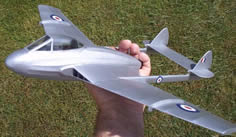 Graham Potter’s large Easy Built Venom in hand and (below) in flight over Old Warden.
- Graham Potter
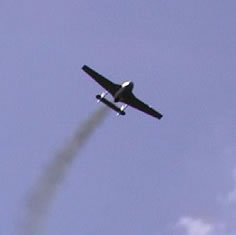 
- Howard Metcalfe
|
|||
|
“Having used a whole box of 32 pellets [about £15], I am really quite encouraged. The best results were with my old 50C and three (uncrushed) pellets, which reliably gave 20+ seconds of useful thrust. Summing up, I'd say that the fuel is still not a patch on the vintage ICI stuff, but it ignites first time using the old method of ignition. The smell is wonderful, but the motors get very hot and my red anodised 50Z (right) is now pink!” Many thanks, Andy. 50C motors are readily available and still quite cheap. Certainly they are to be preferred to the 50Z. Jetex gauzes are also to be preferred: the ‘bowler hat’ gauze doesn’t facilitate ignition; and is ineffective in preventing nozzle clogging. Most dangerous! I would like to see the pellets glazed, and Ben Nead, I know, would argue for a paper wrap. However, if Powermax can modify the gauzes and motor, and the quality control of the fuel is adequate then here at last we have a viable and attractive alternative to Rapiers. The extra weight (½ ounce loaded, about twice that of a Rapier L-2) may also stabilise some models. Worth a try! Encore plus de maquettes volantes d’avions à réaction |
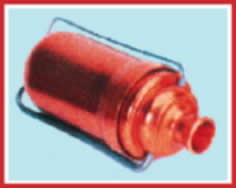 |
|||
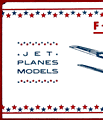
|
|
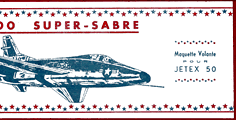 ‘Jet Planes Models’ F-100 kit
- Steve Bage
|
||
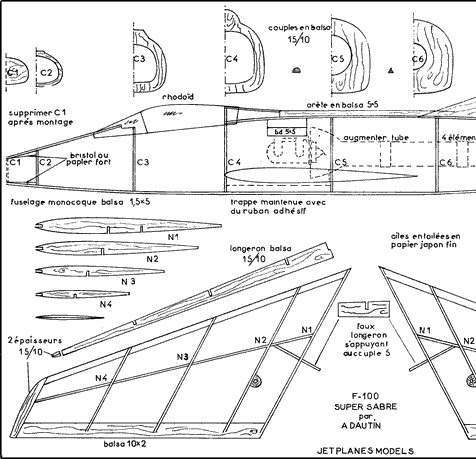 The designer is our old ami, Monsieur A. Dautin, a sophisticated and well-known modeller who has many other nice Jetex models to his credit. Steve was obviously impressed: “It is actually very accurate. The kit includes a detailed 3-view and the plan is an exact copy of this in outline. I really am very tempted to have a go at building it. The planked fuselage would not be so bad, maybe – at least these days we have lightweight filler that can hide a multitude of sins – and the nose and tail cone could be made from block. An extra former could be put in where the fuselage curves sharply into the tail cone. But it’s not easy, and I suspect that few models were actually built and flown.” |
|
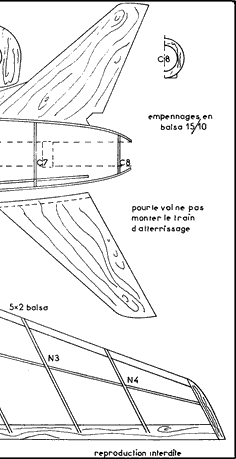 André Dautin’s plan for the ‘Jet Planes Models’ Below: A construction diagram included in the |
||
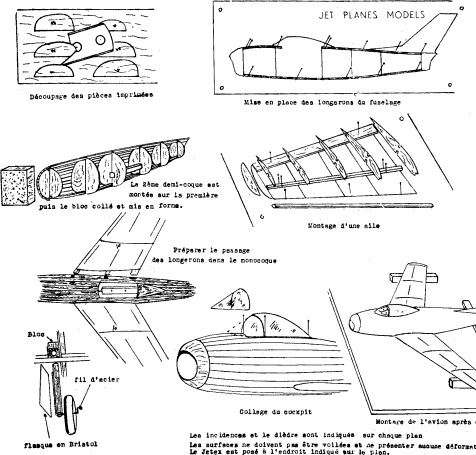 Unlike my CB Mirage, which was only a box, the Super Sabre was in mint condition and complete. It contained the mouth-watering catalogue shown below. |
|
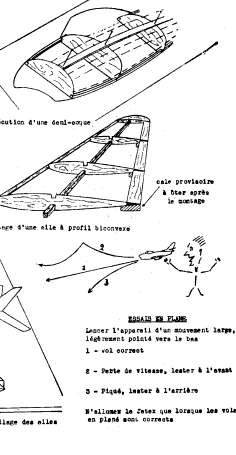 |
||
 John Miller Crawford, our expert on all things French, comments: “There are some real goodies here. The Vautour in particular is one that's appeared in no other guise, and surely the Scorpion is the original of Pierre Claudy's version? The actual brand appears to be Well I never! Merveilleux! Who would have expected it? It would be wonderful if we could track down some of the other kits in the range. I wonder if Pierre Claudy would like to comment on any of this. It is good to end on a high note, with every expectation that eBay will bring forth yet more unexpected treasures, and good-hearted folk to share them. This being the twelfth and final article in the series, I must conclude by thanking everybody who has contributed stories, plans and good advice. Steve Bage of course has been a real star these past two years and it has been good to record his achievements and follow his progress into the stratosphere. I am also grateful to John Miller Crawford for correcting the articles in draft, and to Andy Blackwell for all his help and encouragement. As usual, I am planning to compile them (the articles, not contributors) into a handsome A4 book. That is, if there is enough interest. Please tell me if you would like a copy. |
|
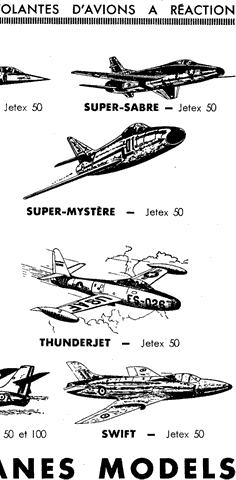 A catalogue included in the kit gives a tantalising glimpse of what may still be out there. The line up appears extensive, with at least two unique offerings – the Etendard IV and the Vautour. The latter may even have been a twin. Why (oh why) had we not come across these models before? |
||
|
|
||||
|
|
|
|||
|
|
|
|
|
|
|
|
Acknowledgements - Article: Roger Simmonds - Illustrations: Roger Simmonds, Steve Bage, Howard Metcalfe, Ben Nead, Graham Potter |
|
|
|
|
ABOUT | MOTORS | MODELS | ARCHIVE | HISTORY | STORE | FAQ | LINKS |
|
|
Terms of Use
|
Queries? Corrections? Additions?
Please
contact us.
|
|